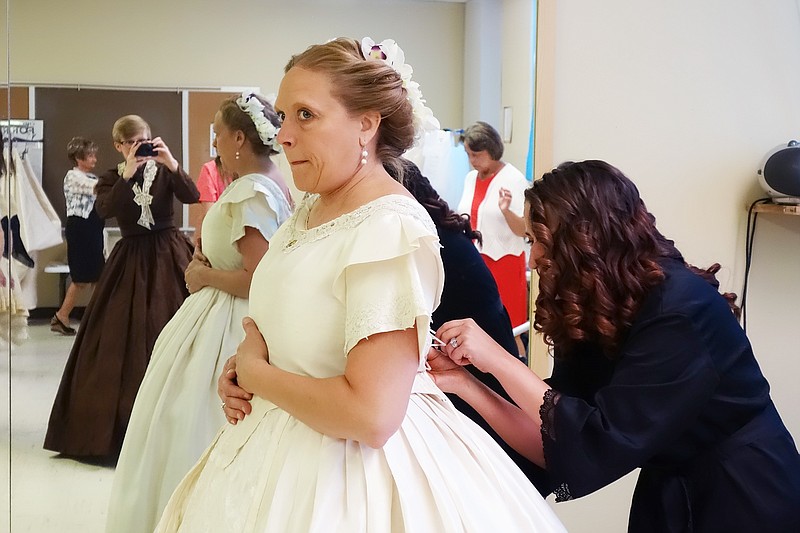A wedding dress is a magnificent creation: the ultimate example of the fashion of its time, made with the latest fabrics and technology.
But all too often, it's worn once, boxed up and never seen again.
The Kingdom of Callaway Historical Society revealed a bevy of antique and vintage wedding dresses to be enjoyed one last time during Sunday's Fashion and Fun Show. Models wore more than 20 dresses, while several more dresses in too delicate a condition to be worn went on display. All dresses, aside from one recreated 1860s-style gown, were originally worn by area brides.
Deby Thompson, one of the models, also regularly does historical reenactments. She enjoys researching the historical women she portrays. She wore the recreated dress, which she handcrafted herself.
"I get to do a little time transport," she said. "It's like getting to be someone else for a day."
Thompson noted that during the 1860s, a new bride often wore her wedding dress to balls for the next year.
Tracing wedding fashions through history revealed a few surprises. One that shocked most audience members: Before the early 1900s, most wedding gowns were not white. The United Kingdom's Queen Victoria started the white-dress trend at her 1840 wedding to Prince Albert, but it took many decades for the practice to become widespread enough to reach rural Missouri.
An 1858 wedding dress originally worn by H. Sarah Meyer showed the era's color at its finest. The tight bodice, bell-shaped sleeves and giant skirt are all crafted of bright red, blue and green plaid.
Many of the older historical dresses are mind-bogglingly tiny. So much so, in fact, that three models had to be 12-year-old girls. The fashion show was a first for each of them.
"I was afraid I'd step on (the dress's hem), and now I'm just afraid I'll trip on air," said Cheyenne Studer, who was tasked with squeezing into some of the show's most elaborate gowns. She paraded them down the catwalk with confidence.
In a formfitting 1929 slip gown, she had to stand perfectly straight and could barely bend her arms enough to hold a bouquet. Behind the scenes, it took three people to help her into the gown.
Originally worn by Helen Dicken Woods to her wedding with Ansel Nichols Mitchell in Kansas City, the dress is made of golden satin and has a lengthy asymmetrical train.
Reece Pahl, meanwhile, had to wear a taped-on bustle made with a Walmart bag beneath one 1888 gown (originally worn by Amanda Smart). She was particularly excited to put on a gown that represented four generations of her family.
"It's my grandma's dress," she said. "It's pretty cool."
Mary Anne Lehman wore the dress when she married Jim Buffington in 1967. Mary Anne's mother handmade the dress from linen brought back from Thailand by her cousin and hemmed it with Alencon lace from St. Louis.
Several audience members had ties to the dresses worn in the show. Fulton resident Debbie LaRue's own wedding dress represented the 1970s with an abundance of frills and flounces. She married Burford LaRue in 1978.
"When I saw (the model) in the gown, I immediately visualized the church full of family and friends at Providence Baptist Church in New Bloomfield who were gathered to share in our special day," LaRue said. "I came home and pulled out our wedding album, and I'm still smiling."
Behind the scenes, Shauna Qualls did the heavy lifting in organizing the event: She wrote detailed descriptions of each gown, matched each with the right model and scripted the show. She's been involved in historical fashion shows since 1991, she said.
"I don't get flustered," she said. "I've done this too many times."
KCHSoc board member Diane Burre Ludwig said the event was a success.
"We were expecting about 85-90 attendees, and we had 100," she said.
Attendees also enjoyed petite wedding-themed refreshments, displays of dresses too delicate to wear and antique wedding toppers belonging to Barbara Binger.
Admission charges for the event went to KCHSoc to aid its mission of preserving Callaway County's history, including caring for dresses donated for the event.
"The dresses must be packed in acid-free paper, which costs $1.60 per sheet, and then stored in $40 acid-free garment boxes that hold two to three dresses each," Ludwig said. "Some of these are being worn for the last time."
The fashion show recurs every two years, so mark your calendars for wedding fashion, part two in 2021

